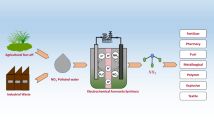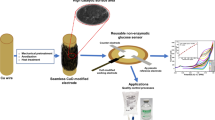Abstract
Molten NaCl–CaCl2–UCl3 was dosed with small amounts of NiCl2 at 600 °C to cause the redox potential to spike upwards. A metallic zirconium rod was used as the working electrode (WE) and was shorted to a stainless steel beaker [counter electrode (CE)] used to contain the salt through a potentiostat operating in zero resistance ammeter mode. The potentiostat simultaneously measured electric current between the WE and CE and the potential of the WE versus a Ag/AgCl reference electrode. With each dosing of NiCl2, the current spiked indicating oxidation of the Zr metal rod, and its open circuit potential spiked and then returned to its initial value or lower. Based on these results, in a molten salt system such as an electrorefiner or molten salt reactor where Zr metal can be an effective redox buffer, this device can be used to continuously monitor the rate at which redox buffering is occurring.








Similar content being viewed by others
References
Roper R, Harkema M, Sabharwall P, Riddle C, Chisholm B, Day B, Marotta P (2022) Molten salt for advanced energy applications: a review. Ann Nucl Energy 169:108924
Guo S, Zhang J, Wu W, Zhou W (2018) Corrosion in the molten fluoride and chloride salts and materials development for nuclear applications. Prog Mater Sci 97:448–487
Ding W, Bauer T (2021) Progress in research and development of Molten Chlorie salt technology for next generation concentrated solar power plants. Engineering 7:334–347
Zhang J, Forsberg CW, Simpson MF, Guo S, Lam ST, Scarlat RO, Carotti F, Chan KJ, Singh PM, Doninger W, Sridharan K, Keiser JR (2018) Redox potential control in molten salt systems for corrosion mitigation. Corros Sci 144:44–53
Hara M, Hatano Y, Simpson MF, Smolik GR, Sharp JP, Oya Y, Okuno K, Nishikawa M, Terei T, Tanaka S, Anderl RA (2006) Interactions between molten flibe and metallic Be. Fusion Eng Des 81:561–566
Simpson MF, Smolik GR, Sharpe JP, Anderl RA, Petti DA, Hatano Y, Hara M, Oya Y, Fukada S, Tanaka S, Terei T (2006) Quantitative measurement of beryllium-controlled redox of hydrogen fluoride in molten Flibe. Fusion Eng Des 81:541–547
Newton M, Hamilton DE, Simpson MF (2020) Methods of redox control and measurement in molten NaCl–CaCl2–UCl3. ECS Trans 98(10):19–25
Bohe AE, Gamboa JJ, Lopasso EM, Pasquevich DM (1996) Zirconium recovery from Zircaloy shavings. J Mater Sci 31(13):3469–3474
Sato, N, Minami R, Fujino T, Matsuda K (2001) Recovery of zirconium and removal of uranium from alloy waste by chloride volatilization method. In: Proceedings of the IEEK conference, pp 179–182
Yoo T-S, Fredrickson GL, Teske GM (2018) Uranium exchange kinetics in a molten LiCl-KCl/Cd system at 500 °C. J Nucl Mater 508:521–529
Bard AJ, Faulkner LR (2001) Electrochemical methods: fundamentals and applications, 2nd edn. Wiley, Amsterdam
Roine A (2018) HSC Chemistry® [Software], version 9. Outotec, Pori
Yang L, Hudson RG (1959) Some Investigations of the Ag/AgCl in LiCl-KCl eutectic reference electrode. J Electrochem Soc 106(11):986
Yoon D, Baggett A, Phongikaroon S, King JA, Marsden D (2019) Fundamental data acquisition toward silver-silver chloride reference electrode. J Electrochem Soc 166(6):E159
Zhang H, Newton ML, Hamilton DE, Simpson MF (2021) High Temperature UCl3 synthesis in molten salt mixtures via reaction of U metal with iron chlorides. J Radioanal Nucl Chem. https://doi.org/10.1007/s10967-021-08060-9
Acknowledgements
This work was made possible via funding from the U.S. Department of Energy’s Versatile Test Reactor program under contract 207312 with Battelle Energy Alliance, LLC. Technical leadership from Joel McDuffee, formerly of Oak Ridge National Laboratory is also gratefully acknowledged.
Author information
Authors and Affiliations
Corresponding author
Ethics declarations
Conflict of interest
The authors have no conflict of interest related to this project or publication.
Additional information
Publisher's Note
Springer Nature remains neutral with regard to jurisdictional claims in published maps and institutional affiliations.
Rights and permissions
Springer Nature or its licensor holds exclusive rights to this article under a publishing agreement with the author(s) or other rightsholder(s); author self-archiving of the accepted manuscript version of this article is solely governed by the terms of such publishing agreement and applicable law.
About this article
Cite this article
Hamilton, D.E., Gonzalez, M. & Simpson, M.F. Application of zero resistance ammeter to real time measurement of redox control in molten chloride salts. J Radioanal Nucl Chem 331, 4863–4872 (2022). https://doi.org/10.1007/s10967-022-08509-5
Received:
Accepted:
Published:
Issue Date:
DOI: https://doi.org/10.1007/s10967-022-08509-5




